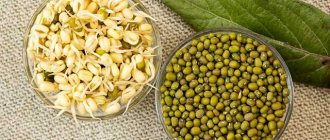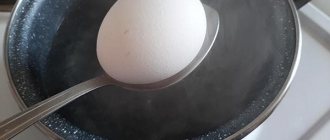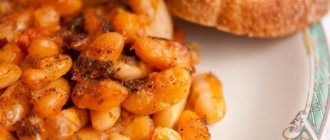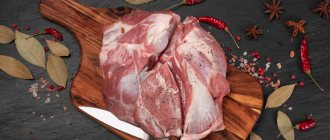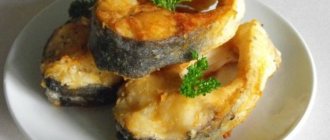Until now, many housewives do not know how and how long to soak chickpeas before cooking. After all, before he was a rare guest on the table of the Slavs. Our mothers and grandmothers mainly used other legumes for cooking: peas, beans, lentils. Chickpeas were popular in the Middle East. The fashion for proper nutrition has led to the fact that Turkish peas have entered the kitchens of Russians. For those who monitor their health and control their weight, it will be useful to learn how to soak and cook a valuable protein product.
Boiled chickpeas in proper nutrition
Chickpeas, also known as chickpeas, have become a regular part of both the diet of the food industry and the menu of the average person. It is loved for its pleasant taste, healthfulness and even aid in weight loss. Some perceive it as exotic and enthusiastically experiment in preparing dishes with it, although in many countries chickpeas have long been an ordinary product.
Speaking of uses, chickpeas are used in a variety of dishes. Italians make chickpea flour from it, which is then used to make fariantas - Italian flatbreads. Hummus and falafel (famous oriental dishes) are also made from chickpeas.
It contains many useful substances and vitamins, for example:
- zinc;
- folic acid;
- lysine;
- vitamin B1;
- vitamin B6;
And some minerals. In addition, it is rich in carbohydrates and proteins. More specifically, for 100 grams of raw chickpeas we get:
- 309 kcal
- fat 4.32 g
- proteins 20.1 g
- carbohydrates 46.12 g
Boiled chickpeas, naturally, have lower indicators. Per 100 g:
- 127 kcal
- fat 1.9 g
- proteins 8.3 g
- carbohydrates 19.3 g
Chickpeas can be used to make not only hummus, falafel, pilaf and hearty soups. It is often used to make cutlets, and some fans add it as one of the ingredients in chili. In addition, boiled chickpeas go great with salads, making them more filling. And in pp-cooking, these peas are good for a variety of main courses, for example, here there is an excellent recipe for chicken with chickpeas.
In order for chickpeas to fully reveal their taste, when cooking you should add a teaspoon of salt and a teaspoon of sugar. But you should do this 15 minutes before it’s ready.
Pilaf with chickpeas and chicken
- 8 boxes of cardamom;
- 160 g round rice;
- 5 g turmeric;
- 2 onions;
- 2 bay leaves;
- 2 g ground cloves;
- 900 g chicken (carcass);
- 170 g chickpeas;
- 160 g long grain rice;
- 3 g cumin;
- 4 peppercorns;
- 9 cloves of garlic;
- 2 g cinnamon;
- 2450 ml water;
- 70 ml sunflower oil;
- 2 g coriander.
Time – 1 hour and 30 minutes.
Calories – 90.
Preparation:
- Leave the chickpeas in water overnight;
- In the morning it must be cooked until fully cooked;
- Leave the washed rice in water for half an hour, after which the water is completely drained;
- Cut the whole chicken into four parts and wash them, then put them in a bowl and pour in water;
- Put on the fire and, when it boils, skim off the foam and add the desired amount of salt and spices to the broth;
- Add peeled garlic and onions here and cook for half an hour;
- Cut the second onion into thin feathers;
- Strain the broth;
- In a separate pan, fry the chopped onion;
- Then add the indicated spices to it, mix, hold on fire for one minute and add peas;
- After half a minute, stir, add rice, stir again;
- Pour in 600 ml of chicken broth;
- Distribute all four pieces of chicken on top, cover the bowl and cook until the rice is completely cooked;
- You can use the rest of the broth as you wish, and instead of chicken, take two chickens. Before serving pilaf, it can be enriched with toasted nuts, herbs, and pomegranate.
With or without soaking
Like regular peas, chickpeas are sold exclusively in dried form. This increases its shelf life and there is no fear that it will become wrinkled during transportation. But that’s not why you need to soak it.
Properly soaked chickpeas:
- it cooks faster - that is, more nutrients remain in it;
- makes it possible to cook as needed for a specific dish. And unsoaked can begin to turn into puree on the outside, while remaining hard on the inside;
- does not provoke flatulence, since soaking neutralizes inhibitors and phytic acid - substances that disrupt the functioning of the entire gastrointestinal tract, prevent the intestines from absorbing many benefits from chickpeas, and block the work of our digestive enzymes. To put it simply, soaked chickpeas will be absorbed as needed and will not cause bloating, unlike dry-cooked ones.
Soak the chickpeas for at least 4 hours . This is enough for it to become soft and easily cooked. There is an opinion that it is better to keep it in water for about 12 hours, but during this time it will not become softer. It’s just more convenient - pour it overnight, and you can cook it in the morning. But there is a danger that after such a long time the chickpeas will begin to ferment, so it is better to hide the saucepan in the refrigerator. But how long to cook the chickpeas after soaking, you will have to decide for yourself - both the dish you want to prepare and the container in which these peas are cooked are important.
Just don’t forget to then drain the water in which the chickpeas were lying and rinse them well. It is in this water that all the “useless things” will be found.
If you need to cook it without soaking, then this can be done, although it is more difficult. To do this you will need to add one teaspoon of soda to 2.5 liters of water - it will help soften the peas. After this, close the lid and cook for 4 hours over medium heat, changing the water a couple of times. But at the same time, the chickpeas will lose some of their nutritional properties and will taste slightly soda.
In some cases, soda is added during the cooking process to soften the chickpeas more. This is usually done to make hummus or falafel, which are made from chickpea puree.
Simple recipes for delicious chickpea-based dishes
If you cook beans in compliance with all the nuances, and at the same time correctly combine them with other ingredients, you can learn how to cook real works of art. Gourmets who don’t care how much time and effort they have to spend creating a culinary masterpiece should pay attention to the following recipes:
Veal with chickpeas in tomato sauce:
- We will need already boiled peas in the amount of 200 g, a piece of veal (also 200 g), carrots, a bunch of parsley and dill, 3-4 fresh tomatoes, spices, salt and dried herbs to taste.
- Cut the meat into small cubes, season with your favorite spices and fry in a dry frying pan with a non-stick coating.
- Pour a little water into the meat, add peeled and diced tomatoes, simmer first over medium, then over low heat for half an hour.
- Add peeled and coarsely grated carrots and simmer for another 10 minutes. Then lay out the chickpeas, mix everything, add chopped greens and herbs.
- Keep this entire mixture under a closed lid for 5 minutes and you can serve.
This dish can be easily prepared in a slow cooker. This approach will even make the process easier and provide the final result with an appetizing aroma and rich taste.
Turkish peas stewed with tomatoes and cheese:
- Take 200 g of boiled chickpeas, a couple of fresh tomatoes, 200 g of Adyghe cheese, a little butter, turmeric, salt, pepper and fresh herbs.
- Cut the cheese into small cubes, trying not to crumble it. In a frying pan or in a slow cooker with the lid open, melt the butter, in which we first fry the turmeric and pepper, then add the cheese.
- While the pieces of fermented milk product are covered with a delicate crust, peel the tomatoes, remove the seeds, and cut the pulp into cubes.
- Add tomatoes to the cheese, fry this mixture for literally one minute and add chickpeas.
- Close the lid of the container. You need to cook (simmer) the mixture for about 10 minutes. After this, add salt to the mixture (taking into account the degree of salinity of the cheese), knead thoroughly, place on plates and sprinkle with fresh chopped herbs.
Boiled peas can be used in soups and porridges, and they add nutrition to light salads. If you fry the component in a small amount of vegetable oil for 5-6 minutes and lightly add salt, you will get an original snack that resembles nuts in texture and taste. But the beans are ready, brought to a puree state, often mixed with creamy processed cheese, and then deep-fried. In general, there are many options for preparing a component; you just need to choose the appropriate one and implement it correctly.
How to cook chickpeas in a saucepan
To begin with, chickpeas should be soaked for several hours. After 3-4 hours, the water is drained, and the swollen peas are rinsed with cold water and poured into the pan. Water is also added there and the cooking process begins, and how long to cook the chickpeas depends on the dish you have planned:
- so that it is soft but retains its shape, cook for 1 hour;
- if puree is required, then 2 hours;
- if you plan to fry it later, then 40 minutes is enough.
In this case, you need to salt the water closer to the end of cooking, and if we are talking about preparing puree, then the water is not salted at all. Salt prevents legumes from boiling!
It’s very easy to check if they’re ready—cooked peas burst easily on your teeth.
Is it necessary to soak chickpeas before cooking?
Before cooking, chickpeas must be soaked. Even in recipes for oriental dishes, the list of ingredients sometimes directly states “soaked.”
During the soaking process, the beans absorb moisture and swell. Therefore, they require less time to boil. Not 1.5–2 hours, but 30–40 minutes. And the shorter the duration of heat treatment, the more vitamins and microelements are retained in the finished dish.
Unsoaked legumes, after boiling, turn out to be tough on the inside and soft on the outside. They look unsightly in salads and pilaf and are not suitable for making purees.
If chickpeas have been in storage for a long time and have dried out, then when cooked without pre-soaking, they will turn out tough and tasteless.
Cooking in a slow cooker
In order to cook chickpeas in a slow cooker, the already soaked and washed peas are poured into a bowl and filled with water so that it covers them by 2-3 centimeters. After this, add bay leaf and cook on the “stew” program for about an hour. At the end you can add salt and other spices.
Many argue that it is necessary to remove the skins from the peas, but this is just a matter of taste. The skins have virtually no effect on the taste of the finished dishes, but they are an additional source of fiber.
Nutritionist's recommendations
Chickpeas, like any other legumes, are great for weight loss. The point is not only in fiber, but also in the fact that it is slowly digested, that is, it gives a feeling of fullness for a long time. However, you should not completely switch to a diet of these peas, since they are quite high in calories, as mentioned above. In addition, it will be useful for strengthening the cardiovascular system and normalizing digestion.
It is well suited for soups and salads, pilaf, and side dishes, making them more satisfying. It is tasty and healthy to eat raw chickpeas after they have swollen in water. You can simply eat peas, or you can keep them in water for 12-18 hours instead of 4 and eat the product that has begun to germinate. In the second case, the amount of protein will decrease, but the fiber content will increase.
There are also contraindications, for example, its excess can, on the contrary, spoil digestion, causing constipation and increased gas production. However, a combination of chickpea dishes with fresh herbs, such as parsley or dill, can help with the latter.
In some cases, there may be a personal intolerance to this product, so you should be careful. If you feel unwell after eating, then do not torture yourself; in the future, refrain from this product.
Final tips
The peas should be the same color and, preferably, the same size. They can be stored in a dry, cool place, away from direct sunlight. If the temperature is from 0 to 5 degrees Celsius, then the shelf life can reach one year. Turkish peas do not require any special packaging. Some people store it in resealable jars, others in canvas bags - there is not much difference. Perhaps it is better to keep it away from spices, as it can become saturated with their smell.
That's basically it. Eat healthy and try new things.
Irina Polyanitsa My name is Irina, I am the owner and admin of the site, as well as the author of most of the recipes and articles. I love to cook simple and healthy delicacies. Certified gym instructor, personal trainer. She completed a course on nutrition and health at Stanford University, Stanford Introduction to Food and Health, as well as a course at Ludwig Maximilian University of Munich (LMU) Nutrition and Lifestyle in Pregnancy (about nutrition and lifestyle during pregnancy).



